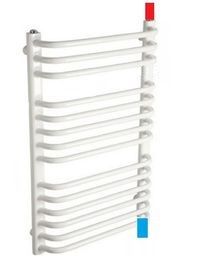FAQ
TL;DR: Cross-connection can deliver 30–40% more output than bottom‑up; "The highest thermal power of bathroom radiators is obtained for top-bottom cross connection." Choose cross when feasible; bottom-bottom is 5–10% lower; bottom-up is not recommended. [“Jak dobrać moc grzejnika do wielkości pomieszczenia”]
Why it matters: This FAQ helps apartment owners, installers, and DIYers decide how to connect a ladder/towel radiator for best heat and least hassle.
Quick Facts
- Efficiency ranking: top-bottom cross is best; bottom-bottom is approx. 5–10% lower; bottom-up can drop 30–40%. [“Jak dobrać moc grzejnika do wielkości pomieszczenia”]
- Bottom-bottom works in pumped systems; expect to bleed it about twice yearly, or fit an automatic air vent. [Elektroda, hajs444, post #18641918]
- Cross-connection advantage shows mainly on large radiators; small units show little difference. [Elektroda, andrzej lukaszewicz, post #17285766]
- Current setup better than both-bottom; cross-connection is ideal and doable using fittings and short pipe sections. [Elektroda, Zbigniew Rusek, post #17279772]
- Place an electric element in the lower corner opposite the return; avoid putting it on the return. [Elektroda, Zbigniew Rusek, post #18640354]
What’s the most efficient way to connect a ladder radiator?
Use a top-bottom cross-connection. It gives the highest thermal power. A bottom-bottom setup reduces output by about 5–10% versus cross. Bottom-up can cut power by 30–40%, so avoid it. “The highest thermal power of bathroom radiators is obtained for top-bottom cross connection.” [“Jak dobrać moc grzejnika do wielkości pomieszczenia”]
Is a bottom-bottom connection really that bad?
It’s acceptable with a pump. Heat still spreads, and rooms get warm. You’ll need more frequent venting, about twice a year. The ladder acts like an air separator. Fit an automatic air vent if manual bleeding is inconvenient. “In forced circulation it does not matter much.” [Elektroda, hajs444, post #18641918]
Why is bottom-up (supply low, return high) the least efficient?
It fights natural stratification and encourages bypassing, so less panel area transfers heat. Tests indicate a 30–40% power loss compared with cross-connection. The configuration is not recommended for bathroom radiators. [“Jak dobrać moc grzejnika do wielkości pomieszczenia”]
Does radiator size change which connection is best?
Yes. Cross-connection helps primarily on large radiators where flow distribution matters more. On ordinary small radiators, the benefit is negligible and often not noticeable. [Elektroda, andrzej lukaszewicz, post #17285766]
Will cross-connecting my bathroom ladder make a noticeable difference?
Expect only a small gain. Cross-connection is most effective, but in a small bathroom the improvement is just a few percent. You likely won’t feel a difference day to day. [Elektroda, hajs444, post #18605112]
Where should I install an electric heating element on a cross-connected ladder?
Avoid the return port. Install the element in the lower corner opposite the return if supply enters from the top. On the return, it can obstruct flow, and the radiator might not heat on central heating when the element is off. [Elektroda, Zbigniew Rusek, post #18640354]
Will a bottom-bottom connection cause chronic air issues?
It often traps air at the top. The radiator can “air out forever” unless you bleed it periodically. This behavior is common with ladders that have both ports at the bottom. Plan for regular venting or use an automatic vent. [Elektroda, Zbigniew Rusek, post #18640354]
How do I bleed a bottom-connected ladder radiator?
- Turn heating off briefly so flow stops.
- Open the top bleed valve with a radiator key until air stops and water runs.
- Close the valve. Repeat seasonally or fit an automatic air vent for convenience. “Such a heater needs to be vented twice a year.” [Elektroda, hajs444, post #18641918]
What if my installation uses a candlestick riser?
Exceptions apply. The simple rule that size dictates benefit can change with a candlestick riser layout. Consult your installer for the best connection in that configuration. [Elektroda, krzsboj, post #17742939]
Will re-piping from bottom-bottom to cross cut my bills?
Probably not much. Measurements indicate bottom-bottom delivers roughly 90% of cross-connected output. That small difference rarely shifts energy bills meaningfully. “Which doesn’t have much impact on your bills anyway.” [Elektroda, sanfran, post #17285271]
If re-piping is hard, should I leave my current connection?
Yes, if changing is difficult. Cross-connection is ideal, but your current layout is still better than both ports at the bottom. If you choose to upgrade later, use fittings and short pipe sections to achieve a cross layout. [Elektroda, Zbigniew Rusek, post #17279772]
Does a bottom-bottom connection work in gravity-fed systems?
It performs poorly without a pump. Circulation deteriorates, and the radiator can keep trapping air at the top. For gravity systems, avoid connecting both supply and return at the bottom to prevent weak heating and air locks. [Elektroda, Zbigniew Rusek, post #18640354]
Can I convert to cross-connection without opening walls?
Often yes. Install angled valves and short external pipe sections to reach the opposite top port. A plumber can execute a neat retrofit with visible but discreet piping. “It is always possible somehow.” [Elektroda, Zbigniew Rusek, post #17279772]




